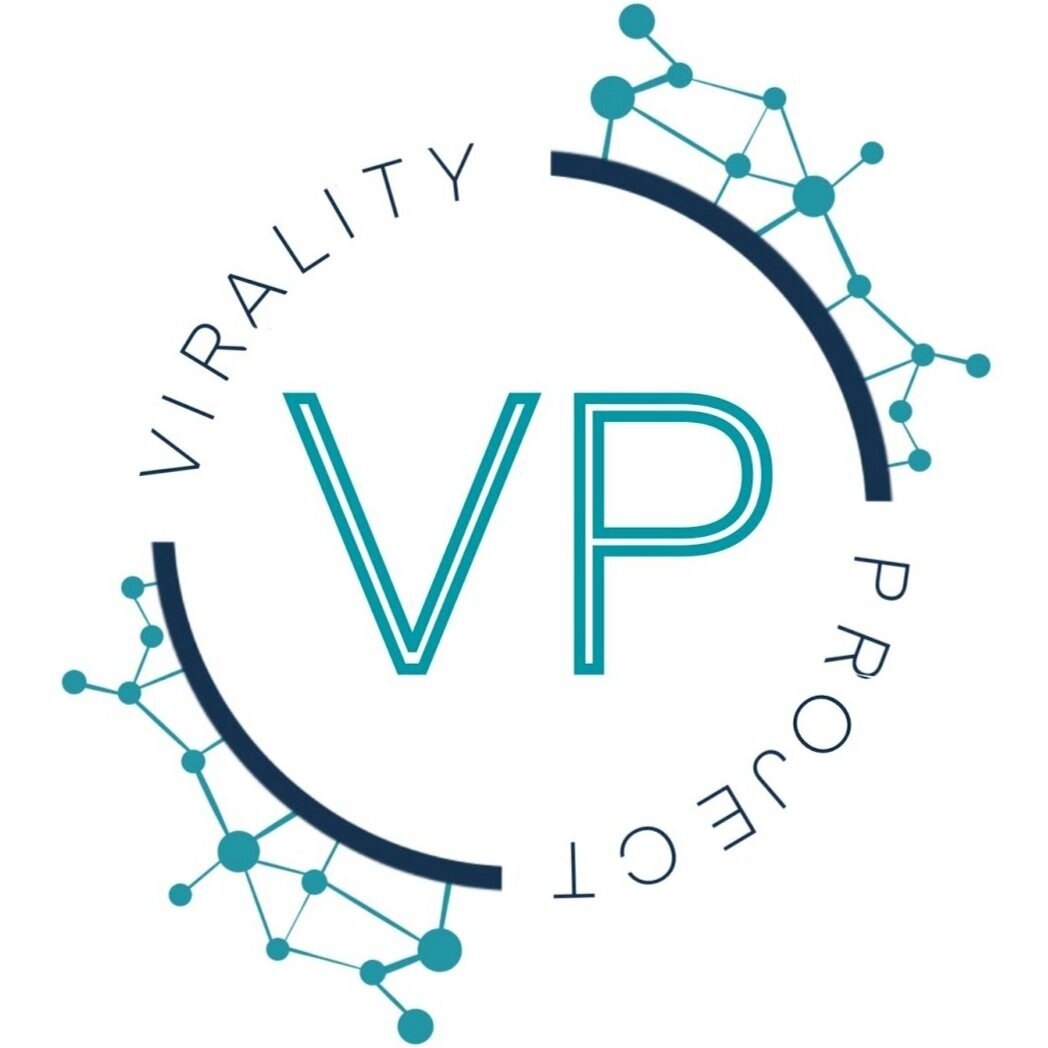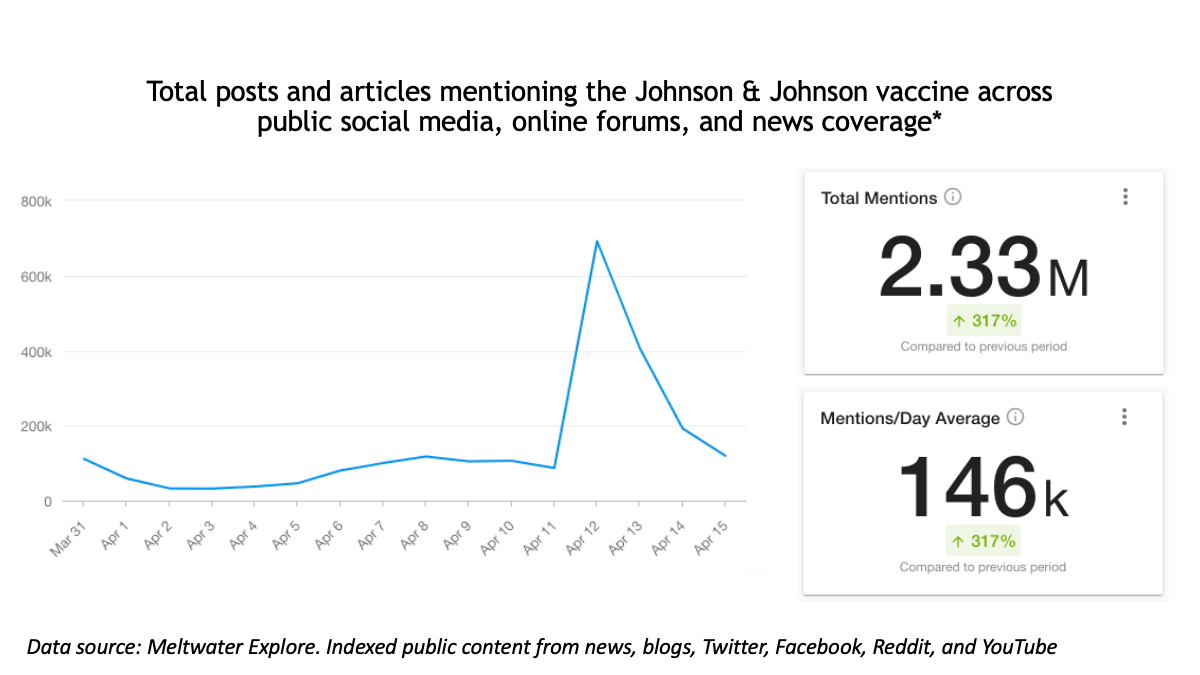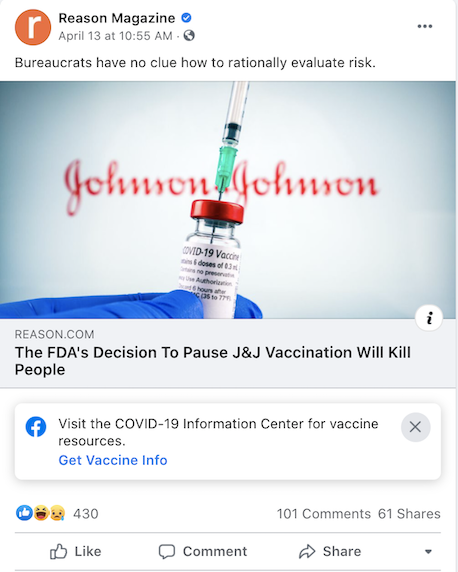J&J Suspension Rapid Response
Authors & Contributors:
Carly Miller, Chase Small, Emma Dolan, Julia Thompson, Jennifer John, Renee DiResta (Stanford Internet Observatory)
Zarine Kharazian (DFRLab, Atlantic Council)
Erin McAweeney, Kyle Weiss (Graphika)
Osiris Cruz-Antonio, Taylor Agajanian (University of Washington, Center for the Informed Public)
Background on the Incident
On April 13th, the FDA and CDC released a statement that recommended pausing the administration of the Johnson & Johnson COVID-19 vaccine after six reported cases in which individuals experienced a “rare and severe type of blood clot.” The CDC’s Advisory Committee on Immunization Practices (ACIP) met on Wednesday, April 15, and voted to uphold the suspension and delay the decision on whether to resume the administration of the vaccine for at least another week. The reported cases are similar to adverse events currently being investigated related to the AstraZeneca vaccine, which is in use more widely in Europe. The European Union weighed in on the J&J suspension, stating on Wednesday that it will be shifting its vaccine rollout plan by not purchasing more AstraZeneca and J&J vaccines; instead, it will put more resources into the Pfizer vaccine.
The number of incidents in question - six - is very small, particularly in light of the 7 million doses of the J&J vaccine administered to date. In the joint statement, the CDC and FDA reiterated that the suspension was “out of an abundance of caution.” However, the experts — even on the ACIP panel — were divided. Some expressed concern that the halt itself might spur hesitancy as well, both in the United States and abroad, especially in the global south. Reporting from the New York Times on April 14th notes that among individuals living in South Africa and other countries that have far more limited vaccine options, this event may have a greater impact on confidence in the vaccine — even for those who have already received it.
Over the past week, Virality Project researchers observed a spike in conversations about the Johnson & Johnson vaccine (Figure 1). Some of this conversation, and shares of articles about the halt, are coming from anti-vaccine activist communities. While some press coverage has interpreted this social media activity as evidence that the halt will increase hesitancy, the actual impact of the pause is presently unclear; recent attempts to quantify the impact of online narratives on general vaccine hesitancy have turned up conflicting evidence. For example, a member of the White House COVID-19 Response team tweeted a new poll by Echelon Insights, which claimed that pausing the J&J vaccine actually increased confidence in vaccines. Meanwhile, another study by Economist/ YouGov, arrived at a different conclusion, finding that confidence in the Johnson and Johnson vaccine decreased after the announcement to pause the vaccine.
This blog post aims to provide more context into how the suspension has been framed by the anti-vaccine community, and to compare that with the coverage within U.S. domestic and global media. We observe that while the reach of content from anti-vaccine influencers on this topic remained largely within the anti-vaccine community itself, right-wing influencers such as Candace Owens and Tucker Carlson were able to achieve much further reach with their posts about the topic, which promoted similar doubts about vaccine efficacy. Even this, however, doesn’t necessarily translate to such narratives having an overall impact on public opinion or sentiment. In this post we also look at the larger information ecosystem, including coverage from domestic and international media outlets, and find that coverage has been mostly neutral, and has not amplified the conspiracy theories leveraged by the anti-vaccine community or the right-wing pundits. Additionally, overall coverage of the J&J suspension has been minimal by volume and engagement compared to that of European countries’ suspension of AstraZeneca in mid March.
Figure 1. A search for mentions of the J&J vaccine across public social media and English-language news coverage via Meltwater Explore showed increased online discussion on April 13, the day the U.S. decided to suspend the J&J vaccine to investigate the link to a rare type of blood clot. The y-axis shows the total posts and articles mentioning the J&J vaccine across multiple public forums.
J&J Narratives within the Anti-Vaccine Community
There appeared to be three prominent, yet contradictory, narratives concerning the J&J suspension within anti-vaccine groups across social media platforms. First, anti-vaccine supporters and influencers framed the adverse events as further evidence of the dangers of vaccines, and occasionally layered in a conspiracy theory that the incidents of clots had been vastly undercounted; these are very common and predictable narratives regularly leveraged by anti-vaccine activists around nearly every prominent instance of a possible side effect, even if the side effect was not found to be caused by a vaccine. A now-removed TikTok video discussing alleged J&J side effects gained moderate traction across Twitter, YouTube, Instagram, and on more fringe sites such as Gab, once again illustrating the pernicious way that unverifiable claims can hop between platforms.
Second, members of the community, as well as established anti-vaccine influencers such as Robert F. Kennedy and his organization Children’s Health Defense created posts that pointed to past lawsuits faced by J&J over a possible link between its baby powder and cancer; these claims have previously fueled J&J-specific vaccine misinformation. They are inflected to create the impression that the company is corrupt, and therefore all of its products are suspect.
Finally, and in something of a contradiction, several anti-vaccine influencers defended the J&J vaccine in comparison to the other vaccine options because it does not use mRNA (something they believe is a dangerous experimental technology). Some of these accounts pointed to VAERS data to justify an unverified claim that the Moderna and Pfizer vaccines are causing three times the amount of blood clotting. Others pushed the conspiracy theory that suspending the J&J vaccine was part of a predetermined plan to leave people no other option but to receive an mRNA vaccine.
Figure 2. A Tweet from a user promoting the conspiracy theory that halting the J&J vaccine was premeditated so that individuals would need to take an mRNA vaccine.
Ultimately, these posts from the anti-vaccine influencers were largely contained within the anti-vaccine community (accounts that commonly share anti-vaccine content, sources, and retweet anti-vaccine influencers) that were already primed to believe the narratives. When Virality Project analysts delved into more “neutral” communities on Twitter — characterized by their lack of sharing of vaccine-related content and their common use of mainstream reporting as a source of information — there wasn’t any indication of new vaccine hesitancy because of the J&J suspension. The conversation within this community mostly consisted of retweets of medical influencers reassuring their followers about how low the probability is that one would develop blood clots from a vaccine, and speculation about how this will increase the spread of vaccine misinformation and hesitancy in the US.
J&J Narratives Outside of the Anti-Vaccine Community
While the conspiracy theories and rejection of the COVID-19 vaccine within insular online anti-vaccine communities are concerning, it is important to look at the extent to which narratives within these communities are able to break out and reach more mainstream audiences — including those who are not anti-vaccine, but are perhaps curious and concerned, or looking for more information. Posts about the J&J halt that got significantly more engagement included one by An0maly, a “news analyst & hip-hop artist” who is able to reach a diverse audience not primarily defined by their views on vaccines. Additionally, Tucker Carlson’s segment on Fox News was the highest-engaged halt-focused post on Facebook this past week, shared 43K times across the platform as of April 16, 2021. Carlson’s segment used litanies of questions to insinuate that the safety and efficacy of the vaccine was still an open question, at one point speculating about whether there might be more than six known cases of blood clots and insinuating that Dr. Fauci and the government were hiding something. This was one of the prominent narratives pushed within the anti-vaccine community, but created by a far more high-profile influencer with an audience of millions.
However, despite the engagement, it remains unclear how Carlson’s segment or commentary from the other high-profile figures will ultimately impact vaccine hesitancy. Popularity on Facebook does not necessarily translate into prevailing popular opinion.
To gain a sense of conversations that might be sparked offline, we turned to coverage of the J&J vaccine by domestic and international news outlets.
Domestic Media Coverage of the J&J Vaccine Halt
We looked at the US media’s coverage of the halt, across central, left, and right-wing categories (defined using the breakdown from the Allsides Media Bias Chart). Across the spectrum, we observed that coverage of the J&J halt was primarily neutral. Many outlets focused on coverage of the FDA/CDC joint statement and live press hearing. In the left-wing media ecosystem, many quoted Dr. Fauci and the CDC and FDA’s joint statement that the pause was out of “abundance of caution.” (see examples here and here). Positive coverage of the halt was found on both in the left-wing and right-wing media ecosystems; one Fox News post discussed the positives of halting the vaccine. At the same time, there were instances of criticism of the Biden Administration’s halt of the vaccine. Much of the non-neutral coverage from the right echoed criticism of the Biden administration’s decision by former President Donald Trump on April 13th, which stated that the reputation of the J&J vaccine would be permanently challenged (see examples here, here, and here). Some left-wing media posts echoed this frustration (i.e., the Daily Beast’s commentary). Additional coverage focused on the question of whether communities would have shaken confidence in immunization overall due to the pausing of the vaccine. However, and importantly, this criticism, is predicated on overall confidence in the vaccine; Reason Magazine, for example, noted that, “The risks of blood clots are much lower than the risks of COVID-19 illness, hospitalizations, and deaths.” (see figure 3).
Figure 3. An article shared by Reason Magazine, a libertarian magazine, that is critical of the FDA’s Decision to pause the J&J vaccine, but ultimately the criticism is based on confidence in vaccines generally
Foreign State Media and International Media coverage of the J&J Vaccine Halt
Russian and Chinese media outlets covered the suspension of the J&J vaccine, and shared their coverage to the social media accounts of their various regional bureaus. Most of the coverage (examples here, here, and here) did not present a particular slant or frame on the suspension, but rather simply reported on the details of the newsworthy event. The Russian state media outlet RT, however, did take the opportunity to cast the Sputnik V in a positive light in comparison to J & J, writing that the Russian vaccine has no reported risk of blood clots, and the developers of the Sputnik vaccine have offered to help other vaccine producers solve problems with theirs.
Comparison: the J&J Conversation in contrast to AstraZeneca
As another measure towards understanding how news of the J&J halt had affected the discussion of the COVID-19 vaccines’ efficacy, we compared the prevalence of the J&J conversation to that of AstraZeneca. We chose AstraZeneca as a comparison because of its similarity in reported potential side effects. Additionally, AstraZeneca is among the most prominent vaccines being distributed globally, which would help provide greater perspective into how the J&J pause may affect the general global vaccine discussion.
Notably, our researchers found that conversation around the Johnson & Johnson vaccine was not as prominent as that around AstraZeneca across various information channels (see figure 4). The top hashtag (other than Covid-19) associated with global Twitter conversation around Johnson & Johnson is #AstraZeneca, suggesting that coverage has complemented existing conversation about the AstraZeneca vaccine. Conversely, Johnson & Johnson is not a top hashtag associated with the AstraZeneca conversation, suggesting that it is not breaking into the broader global conversation in the same way that the AstraZeneca narrative has.
Figure 4. Top: Graph of the common terms surrounding AstraZeneca and J&J on Twitter demonstrates that J&J has captured a much smaller percentage of conversation relative to AstraZeneca. Bottom: Graph of the same breakdown by country. Data source: Meltwater.
In both France and Germany where analysts found the most mentions of J&J, outside of general coverage, the main narratives around the J&J halt were associated with AstraZeneca as another example of yet another “viral vaccine” causing health issues. Interestingly, in France both the far-right conspiracy people and the center-left people are amplifying essentially the same narratives and content. This could be the result of a lack of time for new narratives to form, as well as the shared priming AstraZeneca previously. In Germany, the political right fuses criticism of the vaccines with criticism of the EU generally. The German left is mixed between defending and criticizing the vaccine halt. Overall, tweets associated with the J&J conversation even where they were most prominent, such as in France and Germany, received low engagement relative to those around AstraZeneca.
Larger Takeaways and Implications
It is still too early to know how the pause on Johnson & Johnson vaccine will ultimately affect vaccine hesitancy or vaccine demand globally. An initial look at the varied framings of this incident suggest that while specific groups of incentivized anti-vaccine activists used the J&J incident to undermine confidence in vaccines, the topic was not picked up or widely spread by the broader public in online spaces.





